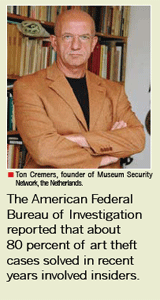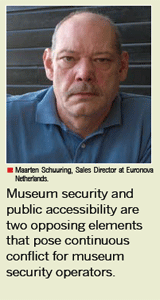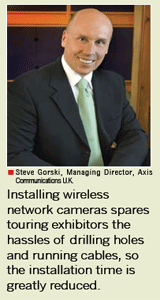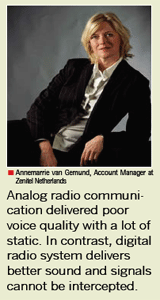Housing treasures of human culture and history, museums are prone to security risks. It is definitely not enough to just install electronics and hope technology will do everything. Museums must also have the right people and the correct procedures to ensure the security of valuable heritage of mankind.
Housing treasures of human culture and history, museums are prone to security risks. It is definitely not enough to just install electronics and hope technology will do everything. Museums must also have the right people and the correct procedures to ensure the security of valuable heritage of mankind.
.gif)
A museum, according to the definition published by The International Council of Museums (ICOM), is a non-profitmaking, permanent institution "in the service of society and open to the public, which acquires, conserves, researches, communicates and exhibits, for purposes of study, education and enjoyment, material evidence of people and their environment." Museums' special roles in educating the public require them to be both cordially inviting and easily accessible to the public. With valuable artworks and artifacts, however, museums are prone to risks of theft, vandalism, accidental damage or fire.
"Because museum collections possess historical value that is priceless and not replaceable, they are targets for illicit activists," commented Alwend Chan, Sales Manager at A&R United Technologies, a Chinese system integrator that specializes in museum security.
One of the major challenges is the task of balancing public accessibility and security. "Museums," said Ton Cremers, founder of Museum Security Network, the Netherlands, "have a very difficult task because they must put their collections in a public place, open their doors and invite everyone to come to take a look." This gives criminals a chance during the day to do their own research of the museum, make their own assessment on how the most valuable objects are displayed and how they can be approached, he pointed out.

The idea of how museum security and public accessibility are two opposing elements that pose continuous conflict for museum security operators is seconded by Maarten Schuuring, Sales Director at Euronova Netherlands. "The fact that you want to show as many objects sometimes interferes with the goal of protecting these objects," he continued. For example, from an artistic point of view, one would not want to put everything behind glass with a sensor located around the glass case.
Statistics on Museum Theft
Interpolthe world's largest international police organizationnoted that theft of cultural objects hits developed and developing countries alike. "The illicit trade in cultural objects is sustained by demand from the arts market, opening of borders, improvement in transport systems and political instability in certain countries," stated on Interpol's Web site.
Meanwhile, the FBI's Art Theft Program indicated that, in the U.S., "art and cultural property crimetheft, fraud, looting and trafficking across state and international linesis a looming criminal enterprise with estimated losses running as high as US$6 billion annually." This figure does not single out museum theft therefore it is difficult to gain an exact idea of how many items of cultural property are stolen throughout the world.
The difficulty of getting the exact art crime statistics for the authorities is also compounded by the reluctance of the victims to identify themselves, especially when internal thefts are involved. Internal theft is one major challenge faced by museums. "The American Federal Bureau of Investigation reported that about 80 percent of art theft cases solved in recent years involved insiders," pointed out Cremers. "These may be employees, former employees, family members of employees or museum contractors," said Steve Keller, President of Steven R. Keller and Associates.
Very often, said Cremers, museums do not make reports to the police because of image and loss of face. "Unfortunately, there are too many examples of museum and library management refusing to give theft public attention or even report theft to the police. Secrecy obstructs the recovery of stolen objects," he added.
Basic Tips for Museum Security
According to Cremers, the very first step that museums should take is to ensure that they have a structured building that is very difficult to enter. Alarms must be triggered at the earliest possible stage. "For building exteriors, you must make sure that, as soon as people enter, an alarm is sounded. If you have only an interior burglar system, burglars will not be discovered until they are inside. Also, burglars do not stay long. That means such systems do not enable security to react quickly enough," stressed Cremers.
Museums must also prevent snatch-grab theft. "The most valuable pieces should be placed on higher floors in burglar-proof display cases or hanging systems so that if anyone grabs anything, the alarm is sounded immediately."
Finally, the key is to have an organized, trained response system. Organizations must be able to react to alarms and take correct measures. "Some museums think that installing a lot of electronics means that they do not need guards, but that is nonsense. Security can never be based only on electronics; that is not enough."

Schuuring agreed this. "On one hand, you have technology, but having only technology is not good enough. You must also have the right people and the correct procedures." The combination of good manning, procedures, physical security and proven technology gives the optimum security for best operating cost. "To reduce cost or improve security one normally needs to invest, but local authorities running museums seem to have missed this lesson and cutting staff without the investment is a disaster," said Clive Stevens, Sales Director of Euronova U.K.
Cremers emphasized that security is based on trust of a good system. A good system could mean establishing firm rules on having the museum staff checked when they enter and leave the premises on a daily basis. "In the Library of Congress, everyone including the staff and visitors get checked upon leaving the premises. That has become part of the daily routine and the same thing can be applied to museums."
A good system may also include storage access procedures, "you must make sure only a limited number of staff have access to the storage area, storage must be closed all the time, and everyone must strictly follow the access procedure, " suggested Cremers.
Security Solutions for Museums
IP Intercom
To control access, and make sure that only authorized personnel is allowed entry in critical locations in museums such as storage areas, labs and curatorial areas, IP intercoms provide a viable solution.
"IP audio and intercom systems are frequently used with video," said Sylvie Hagege, Marketing and Communication Manager at Zenitel France. "This means that people can be seen and audio be heard; identity can be verified by guards in the control room before they are allowed to enter restricted areas."
IP intercom integrates with existing telecommunication infrastructure and provide voice, image, and data links and interfaces using standard Ethernet architecture to bring all streams into one cohesive solution. "It functions as a mini-control center as well as a communication system. Via the GUI, which offers a picture of the site, all auxiliary equipment can be controlled, " added Hagege.
For instance, the GUI directly drives most popular types of CCTV matrices and cameras, giving automatic camera selection, and PTZ functions when intercom buttons are pressed. It also allows CCTV pictures to be brought up on the display or interfaces via IP into door locks, lights, emergency buttons, sensors and panic alarms.
"Launching an alarm is one safety procedure but if one does not describe what's happening, it may be very difficult to react," said Hagege. One can also speak directly to the control room or guards on patrol via a handheld device because the intercoms can be connected to paging systems, SMS and mobile phone networks.
Going Wireless - Wireless IP Cameras and Digital Comm unication
Many museums are historical buildings that have numerous restrictions when it comes to adding cameras or running cables through walls and ceilings, or drilling holes. "The only alternative is to look at a wireless IP solution," said Steve Gorski, Managing Director, Axis Communications U.K.
Installing wireless network cameras spares touring exhibitors the hassles of drilling holes and running cables, so the installation time is greatly reduced. When talking about one U.K. museum that the company has worked with, "we simply did not have the time or resources to install Ethernet cabling through the main galleries before the exhibition started," explained Gorski.

The museum's IT manager had to use the museum's existing wireless network to transfer images from each camera to servers in the central monitoring room." The museum had previously experienced a high profile theft and the thief got away by triggering a fire alarm that released the fire exits. Museum operators requested tightening security around gallery fire exits by putting a delay on the fire exits, but the U.K. law does not allow such a delay and requires direct and immediate release of fire exits when there is a fire alarm.
"We put cameras into the galleries to cover all fire escapes and exit routes," he said. "A wireless network had already been installed so it was very easy to attach wireless network cameras. Today, it is very unlikely that museums or office buildings will not have an Internet infrastructure."
Another wireless application involves digital communication. In the past, radio communication was mostly analog, but now many European countries have TETRA-based public safety radio networks. Zenitel built a digital radio network called Mission Critical Communication Network (MCCN) throughout the Netherlands for the use of non-public safety. "Normal businesses use it for critical communication," said Annemarrie van Gemund, Account Manager at Zenitel, the Netherlands. "Museums use the network for both voice and data communication."
As radio phones are programmed on the MCCN network the way that museums specify, users are able to use the network to talk to each other or send data, including group calls, text messaging, emergency buttons and data transport, said van Gemund. Analog radio communication, she continued, delivered poor voice quality with a lot of static. "It was easy for scanners to intercept signals illegally. In critical situations, such as during transport of valuable art pieces, it was extremely risky as unauthorized people could tap into the signals." Digital radio systems, on the other hand, deliver better sound, and signals cannot be intercepted.
Digital radio's biggest advantage is that it allows for integration with other systems. "The user can receive a signal on his radio when there is for example a fire alarm," said van Gemund, while noting that the museum sector does not like radio devices that are too big or heavy as users require them to be mobile when walking around or standing in the museum. Many also prefer vibration mode as museums must be kept quiet.
Object Protection with Sensors and Detectors
Small sensor cables are used to protect cases that house vases and jewelry displays, said Andy Moon, Technical Director of Advanced Perimeter Systems. "Different sensors are used to secure different museum objects." A small cable runs underneath the wood base of the display case and alarm sensitivity can be adjusted, so that anyone who touches the case generates an alarm either right away or after the sensor detects the vibration several times. "This is particularly useful in a museum when a large number of people are around because frequent vibrations are coming from the floor or small children. You do not want to set off an alarm when that happens," explained Moon.
To protect paintings, said Schuuring, seismic alarms, which are detected through vibration are used. Wood walls or floors, he noted, however, can cause false alarms. "We use small infrared cases, which we place behind paintings, to keep an eye on distance between the detector and painting, changing light, or changing color of light."

Paintings are also protected by sensor cables with different analyzers. A small sensor cable can be attached to the back of the painting or frame unless the frame is worth more than the painting itself as is often the case.
"In this case, we are not allowed to put anything on the frame," said Moon. "What the museum does is to make a false wall by putting some wood in front of the normal wall. The painting is hung on the wall. Then, around the edge, we put a sensor cable. If someone touches the painting, it signals an alarm." Statues, he added, are protected by solid-state sensors (not cables) situated in the base. "The sensor is cut into a piece about one centimeter thick and inserted into the stone base of the statue."
Sensors that create an invisible electronic field are another way to protect statues. If someone comes too close to the statue, it sets off an alarm. "That is used not only to prevent people from stealing the object, but also to keep them from touching it. This electronic shield is much more expensive than a normal detector," said Schuuring. Electronics that sound a small beep rather than a long siren also are useful to give warnings.
Curious people touching objects without meaning to vandalize or burglarize them are a significant threat, said Cremers. "If you have a million visitors each year, and all the ordinary visitors touch the object, in less than a few years, the object will not exist anymore because of the damage, nor is restoration an option."
Touring Exhibitions
Loaned works or traveling exhibitions are especially vulnerable. "Loaned works," said Chan, "are more likely to be targeted by criminals as the works of art are in unfamiliar environments, including during transportation, storage and display. This is why museums, whether the loaning or loaned party, should heighten security requirements."
In addition to wireless IP cameras that spare museum operators the pain of installing wires, sensor cables meet special requirements. "Touring exhibitions usually use fixed sensor cables on painting frames; these can be installed quickly to protect paintings," said Moon.
In addition, simple vibration alarms (battery-operated) do not require additional wiring and are unobtrusive. "The alarms fit on the back of paintings, inside display cases or on objects like vases," said Schuuring.
As such exhibitions usually run two or three months before moving onto the next destination, hanging alarms that combine a strong hanging system and alarm provide a good solution. "Screw the hanging alarm into the wall, hang the painting on a normal picture hook, pull the tag to activate the painting alarm and the security system is armed. The system travels with the exhibition and is easy to install," said Schuuring.
Art transport is riskiest. "Touring exhibitions go from one secure facility to the othe r, but en route, little attention is paid to security. It is like transporting money from one bank to another," said Cremers. He suggested that transport of artwork be done by professional agents in a way similar to money transports.
Challenges and Future Trends
Fireanother dangerpresents a greater risk than theft. "A thief can steal a few objects, but fire can steal the whole collection," said Cremers. "In the U.S., many museums have sprinkler systems but, in Europe, there are not many because of fears of water damage. That concern is misplaced. Fires can be extinguished with one or two sprinklers; furthermore, only those that sense heat start sprinkling."
Many museum managers are also confused about the appropriate use of RFID. "To my knowledge," said Cremers, "most museums use it only for motion detection. I think that this represents a waste of technology. RFID should track and trace objects. Museums that purchase RFID for only motion detectors are falling for hype; that is not what RFID is for. RFID tags do not make any sound so they are the wrong devices for the wrong purpose and they come at a huge investment. Ordinary motion detection sensors will suffice."
Then, there is cost. While large institutions can afford to invest more in security, "That is often very difficult for small private museums, which are usually in old mansions that were not built to be museums. They also have difficulties getting their buildings up to standard," said Cremers.
Schuuring pointed out that level of awareness in various museums regarding the benefits of up-to-date technology are low. That also stems from economic issues. "Some museums are simply not prepared to invest in security because they think that it is a waste of their already limited budgets; they prefer to invest in new exhibitions."
Intelligent video surveillance may offer the right solution. "In retail, network cameras with embedded people counter software count how many people go through the doors of the store. Museums could also use them for the same purpose," suggested Gorski. "Network cameras can be deployed to determine how many people actually look at a specific piece of artwork, generating useful information from a marketing perspective." Furthermore, museums can put images from these network cameras online providing copyright approvals. "That would be a good way to attract people visiting the museum's website as another method of marketing the museum."
Management software is another growing application. "With management software," said Moon, "one takes a photo of the room, then uploads it onto the computer. When the alarm sounds, it shows the exact location of the alarm. It is just like a map, and it helps guards identify locations. If the alarm system is integrated with CCTV, when the alarm goes off, the camera will switch on so that the monitor shows exact status. One can also monitor these alarms via the Internet."
Finally, convergence of IT and security is becoming more common. "In the future, the prevalence of IP will mean that these two departments must work together more closely. An obvious example is that an increasing number of corporations are creating chief security officers," concluded Gorski.